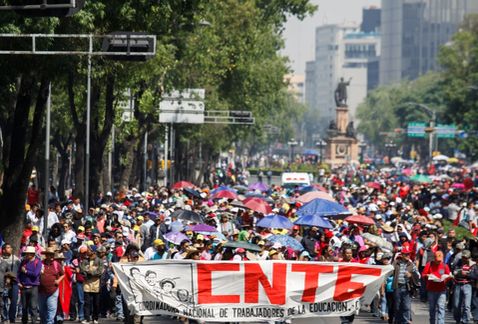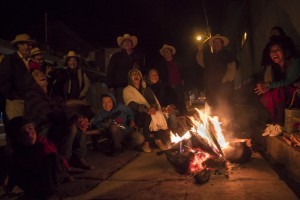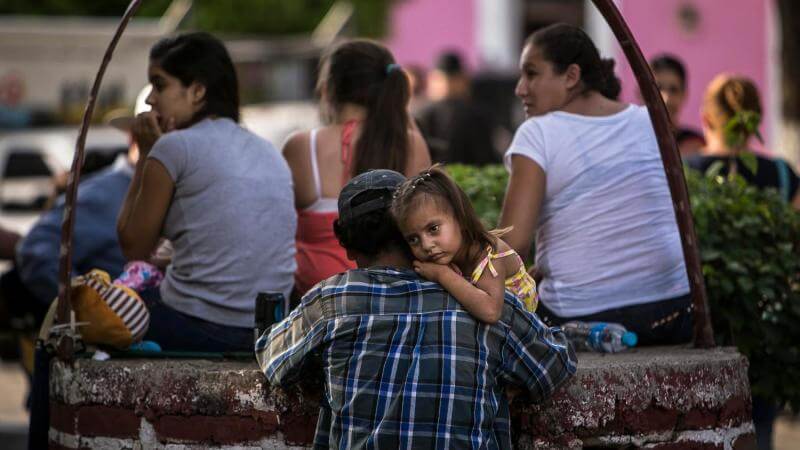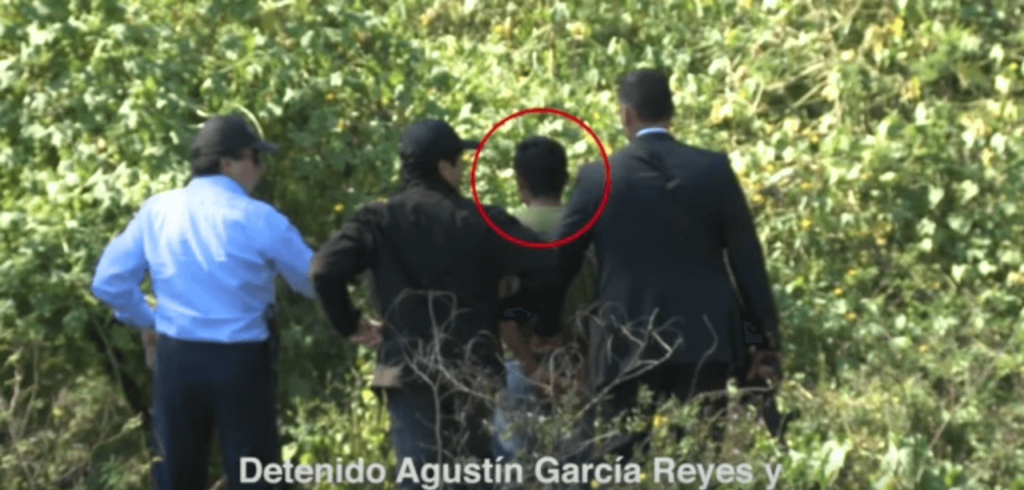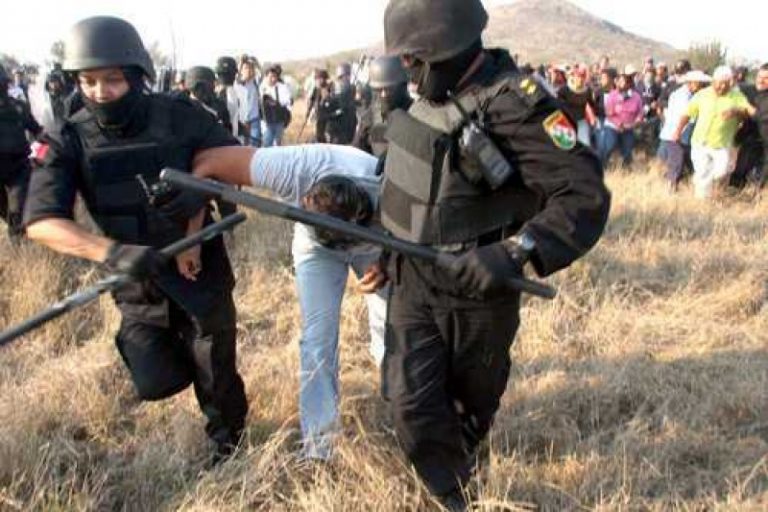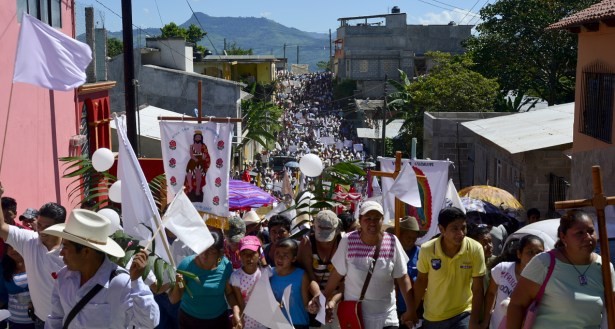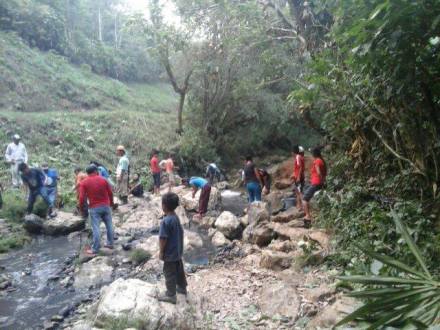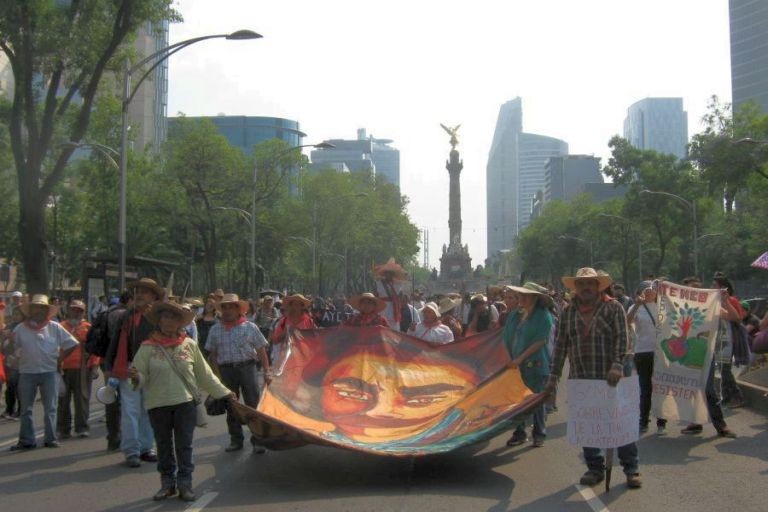Filed under: Editorials, Insumisión, Mexico
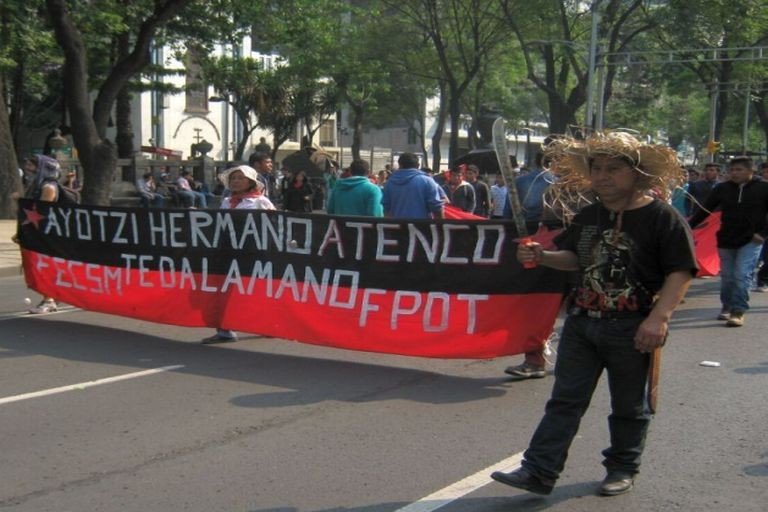
Originally posted to It’s Going Down
By Scott Campbell
As the violence and repression instigated, permitted and perpetrated by the Mexican State continues to grow, it can become overwhelming to summarize it in these pages in a way that does justice to the victims and survivors of state terror and impunity. Yet as the grim tallies multiply and impact more and more lives, so does the clarity that what the state offers even in its best moments is no solution at all, and from that point resistance flourishes. The sparks of refusal and defiance despite the odds ignite around the country, making meaning out of that which seems so senseless, breathing reclaimed life into a panorama of death. As América del Valle of Atenco said earlier this month, “Even with everything they did to us, we don’t come here today as martyrs. We don’t come to cry…We’ve come here to say NO!” Lxs insumxs. Let’s see what they’ve been up to over the past two weeks.
May Day in Mexico was a fairly calm affair this year, though a few bits of news are included in It’s Going Down’s roundup. Hopefully folks were just conserving their energy for today, May 15, when teachers affiliated with the National Coordinating Body of Education Workers (CNTE) begin an indefinite strike against neoliberal education reforms and many other issues, building to a planned boycott of the June 5 elections. The strike could impact the 23 states with CNTE affiliates, though the focus appears to be on Oaxaca, Chiapas and Mexico City. Tens of thousands of teachers will be camped around the Department of Public Education (SEP) in Mexico City. The SEP has responded by saying that any teacher missing three days of classes will be fired. To which the CNTE said, “We dare them to try. We’re ready for what comes.” Teachers in Oaxaca go on strike annually at this time of year, though usually as a tactic to influence negotiations. This year, there are no current negotiations and Governor Gabino Cué has refused to receive their demands, a stance reminiscent of former governor Ulises Ruiz Ortiz in 2006, before he sent the police after the teachers and kicked off a five-month rebellion in the state.
A report by Human Rights Watch from last October has been making the rounds in some Mexican media outlets this month, documenting two massacres by federal police in the state of Michoacán. One in January 2015 in Apatzingán left at least eight dead, while the other, in Tanhuato in May, left 42 dead. “In both cases,” the report reads, “multiple witnesses reported that they saw police officers shoot dead unarmed civilians after the initial confrontations were over.” No police have been held to account. Since the launch of the so-called “war on organized crime,” much of Michoacán has been contested terrain as competing cartels, the police and military, and more recently, armed community self-defense groups – both legitimate and illegitimate, with some being incorporated into the new “Rural Police Forces” – have attempted to impose their will and entered into constantly shifting alliances. Meanwhile, indigenous communities such as Cherán and Santa María Ostula seek self-determination and autonomy in the midst of threats from cartels and the state. Since reclaiming 1,200 hectares of their land from the Knights Templar cartel in 2009, Ostula has seen 34 members of its community killed and six disappeared.
The National Human Rights Commission released the results of a survey this month finding at least 35,433 Mexicans have suffered forced internal displacement, a phenomenon not recognized by the state. The displacement is particularly concentrated in southern Mexico, where even locations previously considered “safe” are seeing drastic increases in violence, usually as the result of an increased presence of the army or federal police. Acapulco, in Guerrero, has experienced 347 killings related to the “war on organized crime” so far this year. A major shootout in the tourist center of the city on April 24 was extensively covered by reporter Francisco Beltrán Pacheco, who for his efforts was gunned down hours later in the doorway of his home.
Also in Guerrero, on May 12 six members of the Regional Coordinating Body of Community Authorities – Community Police (CRAC-PC) were freed after being held for nearly three years on false charges. Gaining their freedom was a major initiative of CRAC-PC commander and recently released political prisoner Nestora Salgado. Speaking of false charges, in another blow to the “historical truth” that the federal government has been offering as explanation for what happened to the 43 disappeared students from Ayotzinapa, an investigation found that 32 of those detained by the government for supposedly being involved in the disappearance and (they claim) killing of the students were systematically tortured into signing confessions corroborating the government’s version. This information corresponds with that already put forward by the United Nations, the Inter-American Commission on Human Rights, and Argentina’s Forensic Anthropology Team. In another case of forced disappearance in Guerrero, one year ago this month, 300 paramilitaries, police and soldiers invaded the city of Chilapa de Álvarez for five days and disappeared 16 people. Local, state and national organizations working on the matter have released a call for all groups seeking justice for the disappeared in Guerrero to unite and organize jointly. Nationally on May 10, Mother’s Day in Mexico, the fifth annual march by the mothers of the disappeared was held in Mexico City and around the country.
In neighboring Oaxaca, the town of San José del Progreso installed a blockade at the main entrance to the Fortuna Silver mine, demanding its removal. Ten other indigenous communities in the state held a gathering at the end of April and announced they will begin, through community assemblies, organizing to oppose several mining concessions on their lands, build cross-community solidarity and strengthen their cultural identity. Upon news that a major investor pulled out of plans to build yet another multinational wind farm on their lands, the Binni’za in the Isthmus of Tehuantepec noted, “Our struggle isn’t over, the debt that PGGM [the investor] and the rest of the multinationals that have invested in our region, that they have with our communities, is large and growing. We will not tire until they recognize our right to live with dignity as the indigenous peoples that we are.” Also in the Isthmus, word is coming out of Juchitán that on May 14, local police severely beat two members of the community assembly of nearby Álvaro Obregón. When community police and others from the Zapotec community arrived to intervene, the local police opened fire, seriously wounding three, including a 14 year old.
To the east in Chiapas, attacks on defiant communities have become more frequent and violent. On May 4, as many as 150 paramilitaries entered the town of Simojovel, inciting panic as they stormed the streets and main park shooting fireworks and tear gas and throwing stones and Molotovs. The town has been organizing through its local church to eradicate corruption and combat drug trafficking. San Sebastián Bachajón, a Tzeltal community adhering to the Zapatista’s Sixth Declaration, announced on May 5 it had recovered more of its communal lands from large landowners. Three days later, off-duty state police attacked a community member. In response, the community detained three state police, saying they would be held until those responsible were punished. At this time it’s not clear how that situation was resolved. Also on May 5, the Tzotzil community of Cruztón, adherents to the Sixth, celebrated nine years since the recuperation of 249 hectares of its land. Again, days later, one of its members was detained and tortured by paramilitaries from a neighboring town. In response, a community member warned, “Our own hands are the ones that will administer justice, like we told the Public Prosecutor, if they don’t do it…The land is ours, the territory is ours, it is our right and this will be ours, whatever the cost.” Most recently, on May 12, police and paramilitaries conducted a joint raid on the Tzotzil community of San Isidro Los Laureles. Mentioned previously in this column, this community – adherents to the Sixth – reclaimed 165 hectares of their land in December of last year. Thirty-five trucks entered the community and the passengers opened fire. The community’s homes were ransacked, belongings burned and crops destroyed. As of this writing, San Isidro Los Laureles’ residents are camped nearby and “creating strategies to recover the land taken by the White Guards [private gunmen].”
Not all is bleak in Chiapas, as the Chol community of Ejido Tila has been sending out inspiring updates and maps on its autonomous project. On May 1, it shared news about the collective work being carried out, as agreed upon by its community assembly. This includes: remodeling public buildings, cleaning up rivers, holding children’s festivals, street and highway cleaning, and community security. “Our town is now safer and cleaner, although there are filthy people belonging to political parties who continue to throw garbage in the street to screw things up and because their father, the bad government, got them accustomed to it. They don’t want to take out the trash when the truck comes, but to throw it in the street instead. We gave them a warning that a green pig will be wheatpasted on their homes if they keep acting uneducated, and although they say they are professionals and that it is us peasants who are dirty and ignorant, well, here it shows what their discriminatory, racist, and conflictive educational discourse is good for.” A second update shared improvements on access to water and the communal justice system, among other items.
Some final pieces of news to share. Earlier this month, San Salvador Atenco marked ten years since the brutal repression unleashed on the town by now-president Enrique Peña Nieto. With marches and concerts, they rededicated themselves to seeking justice for the attacks of 2006 and to continue resisting the latest effort to building an international airport on their lands. To that end, they started planting trees in the path of the new highway for the airport, as well as digging ditches and appropriating and destroying construction equipment. In Chabelkal, Yucatán, the Maya community turned out to stop the eviction of an elder from his home on May 3. The police showed up in 30 to 40 trucks and began beating residents and firing tear gas. Seven were arrested but all were released after 48 hours following intense mobilization and a statement from the Zapatistas and the National Indigenous Congress denouncing the police violence. On May 4, around 150 people were arrested at various metro stations in Mexico City during a coordinated action by #PosMeSalto (So I’ll Jump), a movement encouraging fare evasion that began in 2014 when the metro fare was raised from 3 to 5 pesos. Also on May 4, the Informal Feminist Commando of Anti-Authoritarian Action claimed responsibility for placing an explosive device at Sacmag de México, an investment and construction consulting firm in Mexico City. And lastly, a new report found that the minimum wage in Mexico should be 16,400 pesos per month ($903 USD), as opposed to the current amount of 2,191 pesos ($121 USD).
This edition has been a bit of a downer. To end with some ánimo, here are some compas discussing the anti-authoritarian practices being utilized in the struggle at the Scientific and Technological Studies Center Number 5 (CECyT 5), a vocational school in Mexico City.


